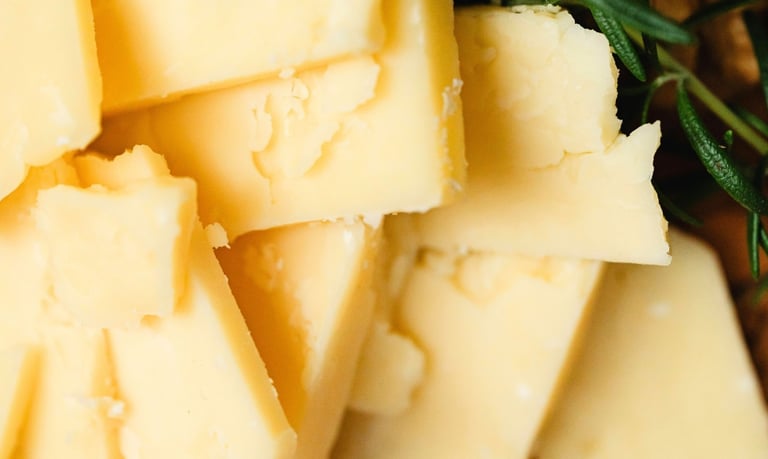Mild, Medium, and Sharp: The Essential Guide to Every Type of Cheddar Cheese
FOODTASTING NOTESFEATURED


Cheddar’s versatility is unmatched. It can star in a grilled cheese, lend richness to a soup, or serve as the crowning glory of a cheeseboard.
Cheddar cheese is a global icon. Born in the English countryside, it has made its way into kitchens and markets worldwide, shapeshifting in flavor and texture as it travels. Its appeal lies in its balance: comforting and familiar, yet endlessly adaptable to refined recipes and casual bites alike.
At its best, cheddar is a study in transformation. Time and technique work in tandem, coaxing a mild, milky sweetness into something far deeper and more complex. Each stage of aging reveals a new personality, offering cooks and cheesemongers an entire palette to work from.
Cheddar’s versatility is unmatched. It can star in a grilled cheese, lend richness to a soup, or serve as the crowning glory of a cheeseboard. Its flavor evolves not only with age but with the milk, the maker, and even the region it calls home.
Today’s cheddar world is a blend of tradition and innovation. Artisans continue to craft it by hand, while large-scale producers refine techniques that deliver consistency without sacrificing quality. The result is an abundance of options - mild, medium, and sharp - that invite exploration.
This guide walks you through the key styles of cheddar, how to use them, and which top-rated blocks to try for each. Whether you’re building a cheese platter or cooking a classic comfort dish, you’ll find a cheddar to match the moment.
Mild cheddar: Creamy and accessible
Mild cheddar is the entry point for many cheese lovers. Aged for only two to three months, it retains a soft, elastic texture and a subtle milky flavor. The tang is understated, allowing the sweetness of the milk to shine.
This style melts like a dream, making it perfect for grilled cheese sandwiches, quesadillas, and baked pasta. Its gentle profile also works well with fresh fruit, especially apples and grapes, where it plays a supportive role rather than competing for attention.
Top-rated mild cheddars
Organic Valley Raw Mild Cheddar Cheese
Certified organic and made with milk from pasture-raised cows, this mild cheddar has a mellow flavor that pairs beautifully with fresh fruit.
Medium cheddar: balanced and versatile
Medium cheddar bridges the gap between mild sweetness and sharp intensity. Typically aged for four to nine months, it develops a richer flavor and firmer bite without losing its meltability. The texture is dense yet creamy, making it a workhorse for cooking and snacking alike.
Use medium cheddar when you want your cheese to make a statement but not overpower the dish. It shines in macaroni and cheese, on burgers, or in a robust cheese sauce for vegetables.
Top-rated medium cheddars
Tillamook Kosher Medium Cheddar Bar
Naturally aged for just the right amount of bite while keeping a creamy, balanced profile.
365 Everyday Value, Medium Cheddar Bar
A creamy, balanced cheddar with a mellow tang, perfect for everyday snacking or melting.
Land O Lakes Medium Cheddar Cheese Chunk
Smooth and slightly nutty with a gentle sharpness, ideal for sandwiches and casseroles.
Amazon Grocery Medium Cheddar Cheese
Mild yet flavorful, this versatile block works beautifully in both hot dishes and cheese boards.
Sharp (aged) cheddar: Bold and complex
Sharp cheddar is where cheddar’s personality truly takes center stage. Aged from one to several years, it develops a deep tang and crumbly texture, with flavor notes ranging from savory and nutty to caramel-like in intensity.
The aging process concentrates the cheese’s character, sometimes forming tiny protein crystals that add an irresistible crunch. It’s a natural match for bold pairings like pickles, charcuterie, full-bodied wines, or even chocolate chip cookies.
Top-rated sharp (aged) cheddars
Cabot Vermont Sharp Cheddar Cheese
Tangy and bold with a crumbly bite, great for cheese plates and mac and cheese.
Kerrygold Reserve Cheddar
Irish-made and aged over two years, with a robust, complex flavor and firm texture.
Tillamook Extra Sharp Cheddar
Bold and tangy, this cheddar delivers a full-bodied bite that lingers.
Cabot Creamery Vermont Seriously Sharp Cheddar Cheese
Intensely savory and slightly crumbly, showcasing Vermont’s signature cheddar character.
Organic Valley Raw Sharp Cheddar Cheese
Rich and robust with a natural complexity, crafted from pasteur-raised cow's milk.
Cheddar pairings and storage tips
Pair cheddar with accompaniments that highlight its flavor profile. Mild cheddar loves crisp apples, pears, or fresh berries. Medium cheddar pairs well with chutneys, spiced nuts, and sourdough bread. Sharp cheddar stands up beautifully to cured meats, bold mustards, and wines such as Cabernet Sauvignon or Malbec.
To store cheddar, wrap it in parchment paper or wax paper, then loosely in a bag. This allows it to breathe while preventing it from drying out. Avoid plastic wrap as it can trap moisture and encourage mold growth. Properly stored cheddar will keep for several weeks in the refrigerator.
Final crumble: Why cheddar still reigns supreme
Cheddar’s enduring appeal lies in its ability to be both humble and gourmet. It is equally at home in a rustic picnic basket and on a Michelin-starred tasting menu. Its flavor can be mild and comforting or sharp and commanding, yet it always remains familiar.
Across its spectrum, cheddar reflects a harmony of tradition and innovation. The mild versions recall its pastoral roots, while the aged varieties showcase the craftsmanship and patience of skilled cheesemakers. Cheddar has traveled the world, adapting to local tastes and techniques without losing its essence. It’s a cheese that invites both loyalty and curiosity, offering endless opportunities to taste, compare, and savor.
Rediscover cheddar with intention. Build a board with a mild, a medium, and a sharp block this weekend, and taste how time transforms one of the world’s most beloved cheeses.
